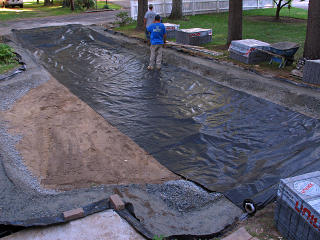
This wasn't the way the fabric actually got installed; they were just rolling out and measuring lengths here.
Day 3

|
It was time to build the drainage bed, so the first thing that needed to
go down was the geotextile liner. Same principle as the infiltration
structure
under the street,
just a shallower base. And a different type of filter fabric; the GC
seemed to favor the plastic woven style over the felt-like stuff.
This wasn't the way the fabric actually got installed; they were just rolling out and measuring lengths here. |
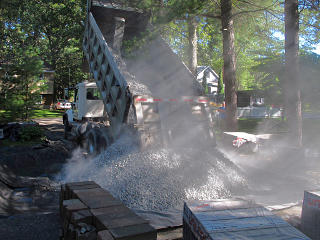
|
A truck from the same local company that had supplied the road job arrived, with a load of the same inch-and-a-half-ish drainage stone. I found this highly amusing. Unfortunately it was a different driver today, who hadn't delivered to that other job and wouldn't have seen the mild irony of coming back to almost the exact same spot three months later. Anyway, with a similar great whoosh and dust cloud, we got a big mound of rock. |
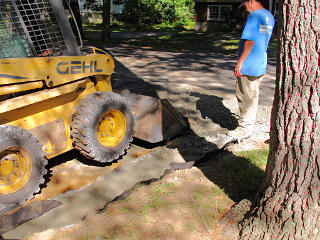
|
More of the temporary ramp got taken out, as part of the drainage bed had to come right up to here. |
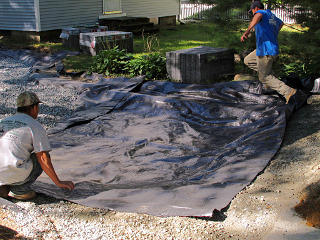
|
The last swatch of fabric was laid down. I was expecting another truck would be by to deliver more of the large stone to fill this area. |
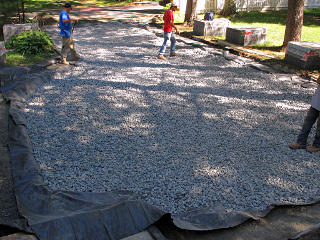
|
Instead, what we already had got spread further into this area until it covered as much of the bottom as it was going to cover in a uniform depth. |
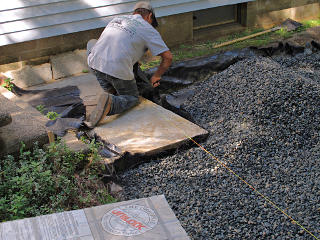
|
Now the excess fabric could get trimmed away. Note how the grade line comes in right over the slab, just skimming it to the reference point. The final surface would match this. |
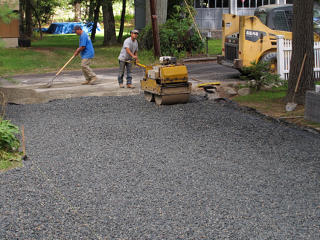
|
But they weren't done flattening! Time to roll what we had, to sort of lock all that loose rock together underneath. |
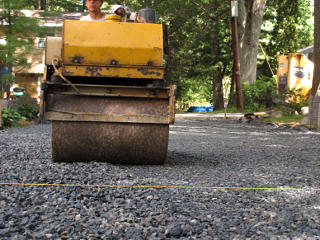
|
The layer of smaller gravel compacted down a noticeable amount, presumably transferring some amount of that displacement into the layers below too. |
| The thing about a driveway as opposed to a drainage/infiltration pit is that the driveway needs to take heavy loads and not move. Rather than the relatively delicate web of round "river rocks" barely touching each other that I'd favor for the former, the idea here was that the more angular rough-crushed stone would all lock itself in with much more friction and be relatively immovable thereafter, but without any fines in between still have plenty of percolation space. There's a definite science to this, and good reasons behind the selection of material sizes. So everything needs to get mashed down as far as it's going to get, while there's still access to it. |
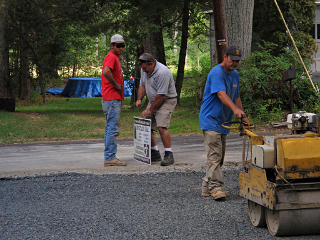
|
The project manager arrived during all this, with a promotional lawn sign to set up. We discussed the activities and progress to date and the minor few things to think about. |
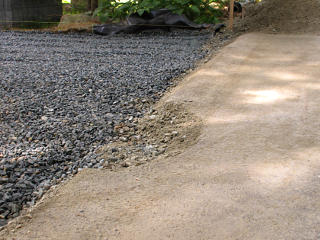
|
Once the asphalt berm was cleared off, we saw that it had taken some pretty good damage. This wasn't going to deflect water anymore... |
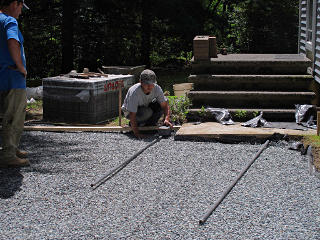
|
So if we thought things were flat and level now, just wait. Next was to set up some guide pipes which would help dictate how the 3/8" stone got spread out. |
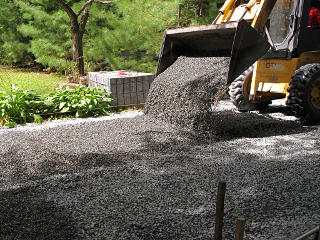
|
And that would be, very thinly, basically about an inch of layer, just enough to cover the pipes. No, the pipes weren't getting buried in there. |
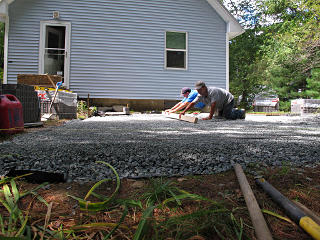
|
Very, very flat. |
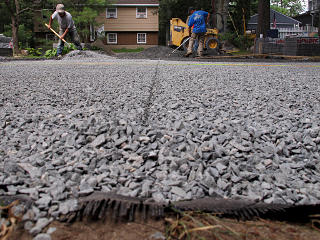
|
This left behind little channels where the pipes had been, but they'd get filled in later. |
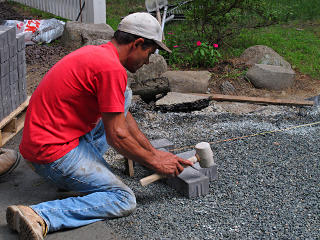
|
And the first couple of pavers were officially laid, lightly tamped flat onto the bedding layer. [The edge-pattern model didn't count, they'd get moved again.] |
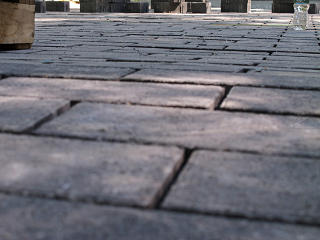
|
The thumping-down process was only rough alignment, and the minor bits of height unevenness remaining were totally unimportant as the whole layout was going to get compacted anyway. |
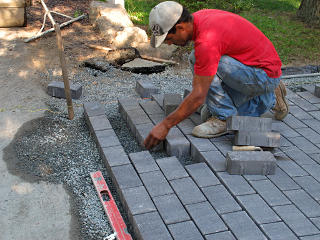
|
The guy wasn't entirely happy with the match going over the end rise, and pulled a few out to shift them around and reseat them and make it better. |
|
They cleaned up a bit and trailered the bobcat, as it wouldn't be
needed anymore for either digging or lifting duties. There was more
room to do that down at the intersection near where the
water main work
had been done, which left a couple of minor skid marks on the road
as after all, there's a reason they call it a "skid steer" loader. They
certainly didn't damage anything, far less than kids out experimenting
with coefficient of friction [read: "burnouts"] would have. But
the Evil Developer came by later and mildly bitched out the crew
about that, like it was still "his road" or something. It isn't;
he might have paved it, but it's town property.
But along with griping about some tire prints, he looked at the half-laid driveway saying "it's beautiful!" Well, you know how a lot of Italians are about stonework. But in theory he would have eleven driveways to build as the houses went up back there, and it was highly amusing that he asked the crew for a business card. Not all the 3/8 stone got used -- that was the height-critical layer that *had* to sit at just the right level to bring the pavers to the grade lines, so the rest couldn't just be cheated flat over a wider area. The excess had gotten piled at the corner of the area on the street, adding to a bit of aggregate that was already there and making a bit of an obstruction along that side. My car was already parked along the same general path a little farther up too, so the head guy simply parked his dump truck across the end of the driveway for the overnight and made it all a continuous line of obvious objects that people would simply drive around. He had the crew-cab pickup to get him and the guys home for the night. |
Day 4
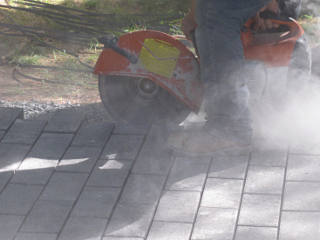
|
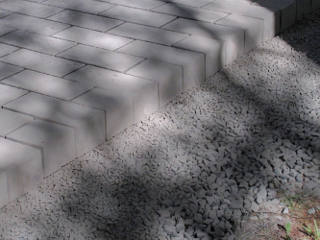
|
|
The diamond blade made short work of this, though, leaving a very cleanly cut
edge. He cut such that the little alignment nibs on the shorter runs also
got mostly buzzed off too, because otherwise the blocks being cut in half
would be too long to match up right.
Then I thought, isn't concrete sawing usually a wet process, if nothing else to cool the blade? Well, there's a water fitting on the saw guard but later when discussing it, they pointed out that wet sawing lets the resulting ultra-fine slurry run down into the substrate and mess up the work. The only other choice seemed to be letting it fly up and away. Well, the right answer turns out to pretty much be a no-brainer. They need one of these. There's even a video showing it being used with the same saw. | |
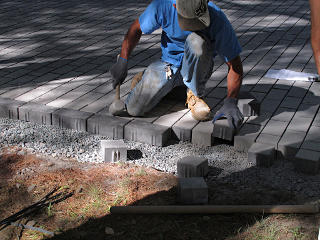
|
The head guy began laying the runners, flipping the cut half-blocks around along the way so there would at least be *some* of the nibs exposed to help align with. |
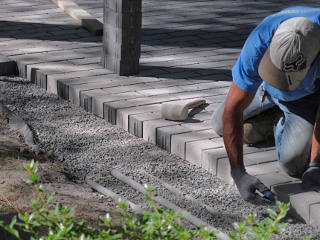
|
The edge to match took on an amusing alternated look, with half the ends covered in dust and the flipped ones still clean. |
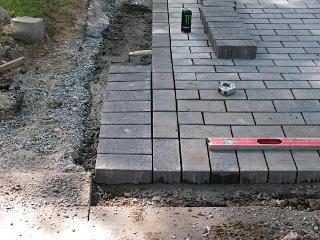
|
Having completed the front row, he turned the corner and started down the side. |
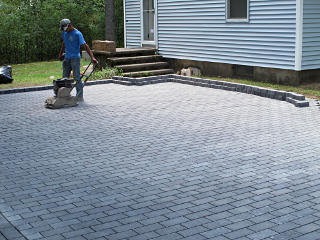
|
Then it was time to vibrate down the freshly installed rear half of the
whole thing, being careful to not go onto the soldier row more than about
an inch as long as the concrete was still soft. But not stay off it
entirely, as the inner ends of those blocks had to line up with the
final level too. He drifted onto the soldiers by maybe an inch or
so, and rechecked all the alignment afterward.
I took a short video (1.2 Mb) of the compaction process, in which the leveling mechanism is fairly clear. Best shown by one particularly high block near the middle of the vibrator's run -- down she goes! |
| This was the Saturday starting off Labor Day weekend, and by midafternoon they'd reached a good "unit of work done" stopping place *and* had run out of pavers to lay out for the moment. They'd have to bring a few more when resuming on Tuesday, but for now it was time to pack it all up and go enjoy the rest of the weekend. Yup, they [and I] were fine with them working on Saturdays. |
Up (main house pages)
_H* 140905